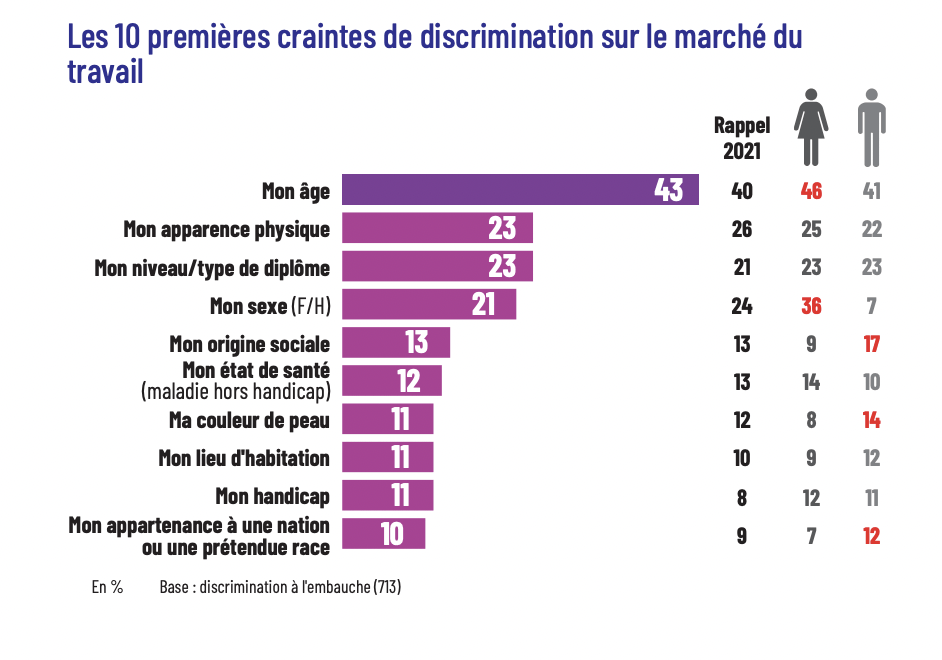Senior Index: definition
The Senior Index proposal dates back to 2019. The idea for this index, in the same vein as the existing professional equality index, came from the Association Nationale des DRH (ANDRH).
At the start of the year, Elisabeth Borne’s government and Olivier Dussopt, the French Minister of Labor, announced the forthcoming publication of the senior index, which will be mandatory from 2023 for companies with over 1,000 employees.
The aim is to give companies a greater sense of responsibility when it comes to hiring and retaining older employees, in order to address the low employment rate of 55-65 year-olds in France.
The senior index, based on a number of as yet undefined indicators, should encourage companies to be more transparent on the subject of employing seniors, and promote good practice, while also providing for financial penalties for poor performers.
Which indicators should be selected for the senior index?
The Minister of Labor did not detail the indicators that will be used to set up this senior index. These indicators should be defined following consultation with the industry, but there are already a number of detractors, including Medef, which is opposed to the index in principle.
The index of professional equality used as an example operates with a 100-point indicator of respect for gender equality in the workplace. To be transposed and applied to age-related issues, it would be necessary to select several indicators, such as the rate of internal professional mobility of the over-55s, the proportion of older employees in recruitment (age is currently the leading cause of discrimination in hiring) or their access to training.
For Benoît Serre, Vice-Chairman of ANDRH, this senior index would help to change attitudes to the employment of seniors, by addressing both the issues of recruiting seniors and those of career development and dynamics.
Senior index: pros and cons

While the ANDRH and the government see this index as a way of encouraging the retention and recruitment of older employees and their access to employment, not everyone agrees.
Indeed, some opponents of the measure argue that by raising the retirement age, it is actually the length of time older workers remain unemployed that will increase, but not their career in the company. In this respect, current figures are clear: at 60, 52% of people living in France are still in employment, 41.4% of them full-time. At 62, only 28.2% of them are still in work (according to figures from the Conseil d’Orientation des Retraite report of September 2022). It would appear that the primary variable for adjusting a company’s workforce remains its older employees.
For others, imposing indexes or quotas will not solve the problem of senior employment, which is first and foremost a problem of senior employability. Seniority (experience) is no longer seen as an asset by the company, but as a heavy financial burden.
Medef fears that this senior index will generate too many constraints for companies.
At 62, only 28.2% of seniors are still in employment.
What are the implications for companies, and how can you successfully implement the senior index within your organization?
Beyond the forthcoming obligation to comply with the publication of this senior index, it is above all the mentality within companies and HR departments that needs to change.
The index alone will not solve the problem of employment for older workers, and concrete action within companies will be needed in addition to public policies in this area.
The role of HR in seniors' employability
Companies and human resources departments need to understand now that they will have to deal with an increasingly older workforce in the years ahead. As a result of longer working hours, today’s 57-58 year-olds will be tomorrow’s 61-62 year-olds. So as not to delay the problem, HR has a role to play right now with future seniors.
Indeed, age discrimination is the only discrimination not yet addressed within companies, even though it is the number one source of discrimination perceived by employees according to the equal opportunity perception barometer published in September 2022 by MEDEF.

Companies, through their HR departments, therefore need to think ahead and take specific measures for employees from the age of 50, to avoid reproducing the problem five years down the line. Forward-looking management of jobs and skills (GPEC) must now include a “senior employment” component. While some companies have already begun to set up skills assessments and specific training plans, or to offer validations of acquired experience to these populations, the commitment to employing seniors is a challenge for companies and HR departments in the years to come.
Age discrimination is the number one fear for employees
Calculating the senior index: the central role of HR
In line with the professional equality index, the calculation of the senior index will be the responsibility of HR. The HR department needs to get to grips with the subject, as it will be responsible for calculating the score, explaining it and analyzing it in order to identify areas for improvement. Although the subject ultimately concerns the whole company, it’s up to HR to be the driving force behind it. If companies simply calculate the index, there will be no impact. It’s a question of taking the necessary measures, with foresight. Indeed, with this index the score can swing from one year to the next depending on retirements, so it’s never a given. This is a real opportunity for HR to demonstrate its added value.
This index implies firstly an audit of the company’s actions in favor of the employment of seniors, and secondly the implementation of new specific measures to improve the score. There is room for improvement in training (only a third of the over-50s continue to take part in training) and in career-end planning (adaptation of working hours and remuneration).
To implement the senior index, companies’ HR departments can, for example, call on the services of
time-sharing HR departments
to free up time for these new issues, or to delegate the implementation of the index.
For everyday support: https: //www.boostrh.com/services-rh/politique-et-strategie-rh/
THE EXPERT'S OPINION
Ariane DRH CHEZ BOOST’RH GROUPE
According to our expert, the senior index follows the same logic as the professional equality index, hence the government’s use of the same term. The professional equality index is fairly restrictive, insofar as the law clearly defines what it must contain and how it must be calculated. This makes it very objective and easy to understand. Based on its experience with the professional equality index, the government must be convinced that this is a tried-and-tested method that gets things moving, hence its transposition to seniors,” assumes our expert.
If we continue with the transposition between the two indexes, it is therefore likely that the calculation of the senior index will be restrictive to ensure maximum objectivity and universality. Similarly, while it has been announced that it will be compulsory for companies with over 300 employees, it is a safe bet that this will soon be the case for companies with as few as 50 employees.
Beyond the index, the employment of seniors is part of the underlying trend towards integration, inclusion and diversity. Lately, companies have been finding it harder to recruit, as candidates and employees are looking more and more closely at the company (image, CSR). The senior index is therefore an opportunity that companies can seize in terms of employer branding and CSR. In conclusion, according to our expert, employing seniors could also be part of the answer to the recruitment issue and the difficulty of recruiting. Companies could look for candidates in a population that is rather at the end of its career, and which they tend to rule out as possible candidates at the moment.
To sum up
The senior index is an index that measures the employment and hiring rate of senior employees (over 55) within companies. Its aim is to help older workers remain in employment in the face of longer working hours. The index will have to be published by companies with more than 300 employees, and non-compliance may give rise to financial penalties.
The indicators for calculating the senior index have not yet been defined at the start of 2023. They will have to be decided following professional consultation. A priori, the indicators evoked are: the rate of training, hiring and professional mobility of seniors.
Human resources will have to deal with an older workforce in the coming years. HR managers therefore need to take these developments into account in their career and job management. Companies’ HR strategies will therefore have to evolve with a view to improving the employability of older workers: job retention and recruitment.

